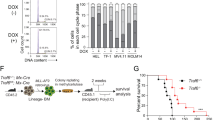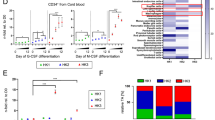Abstract
Cell proliferation requires a constant supply of lipids and lipid precursors to fuel membrane biogenesis and protein modification. Cytokine stimulation of hematopoietic cells directly stimulates glucose utilization in excess of bioenergetic demand, resulting in a shift from oxidative to glycolytic metabolism. A potential benefit of this form of metabolism is the channeling of glucose into biosynthetic pathways. Here we report that glucose supports de novo lipid synthesis in growing hematopoietic cells in a manner regulated by cytokine availability and the PI3K/Akt signaling pathway. The net conversion of glucose to lipid is dependent on the ability of cells to produce cytosolic acetyl CoA from mitochondria-derived citrate through the action of ATP citrate lyase (ACL). Stable knockdown of ACL leads to a significant impairment of glucose-dependent lipid synthesis and an elevation of mitochondrial membrane potential. Cells with ACL knockdown display decreased cytokine-stimulated cell proliferation. In contrast, these cells resist cell death induced by either cytokine or glucose withdrawal. However, ACL knockdown significantly impairs Akt-mediated tumorigenesis in vivo. These data suggest that enzymes involved in the conversion of glucose to lipid may be targets for the treatment of pathologic cell growth.
This is a preview of subscription content, access via your institution
Access options
Subscribe to this journal
Receive 50 print issues and online access
$259.00 per year
only $5.18 per issue
Buy this article
- Purchase on Springer Link
- Instant access to full article PDF
Prices may be subject to local taxes which are calculated during checkout





Similar content being viewed by others
References
Alli PM, Pinn ML, Jaffee EM, McFadden JM and Kuhajda FP . (2005). Oncogene, 24, 39–46.
Bauer DE, Harris MH, Plas DR, Lum JJ, Hammerman PS, Rathmell JC, Riley JL and Thompson CB . (2004). FASEB J., 18, 1303–1305.
Beigneux AP, Kosinski C, Gavino B, Horton JD, Skarnes WC and Young SG . (2004). J. Biol. Chem., 279, 9557–9564.
Bellacosa A, Testa JR, Staal SP and Tsichlis PN . (1991). Science, 254, 274–277.
Bentley J, Itchayanan D, Barnes K, McIntosh E, Tang X, Downes CP, Holman GD, Whetton AD, Owen-Lynch PJ and Baldwin SA . (2003). J. Biol. Chem., 278, 39337–39348.
Berridge MV and Tan AS . (1995). Biochem. J., 305 (Part 3), 843–851.
Berwick DC, Hers I, Heesom KJ, Moule SK and Tavare JM . (2002). J. Biol. Chem., 277, 33895–33900.
Bligh EG and Dyer WJ . (1959). Can. J. Med. Sci., 37, 911–917.
Board M and Newsholme E . (1996). Biochem. Mol. Biol. Int., 40, 1047–1056.
Boudreau DM, Gardner JS, Malone KE, Heckbert SR, Blough DK and Daling JR . (2004). Cancer, 100, 2308–2316.
Conlon I and Raff M . (1999). Cell, 96, 235–244.
Dang CV and Semenza GL . (1999). Trends. Biochem. Sci., 24, 68–72.
Deprez J, Vertommen D, Alessi DR, Hue L and Rider MH . (1997). J. Biol. Chem., 272, 17269–17275.
Dimitroulakos J, Nohynek D, Backway KL, Hedley DW, Yeger H, Freedman MH, Minden MD and Penn LZ . (1999). Blood, 93, 1308–1318.
Edinger AL, Cinalli RM and Thompson CB . (2003). Dev. Cell, 5, 571–582.
Edinger AL and Thompson CB . (2002). Mol. Biol. Cell, 13, 2276–2288.
Elstrom RL, Bauer DE, Buzzai M, Karnauskas R, Harris MH, Plas DR, Zhuang H, Cinalli RM, Alavi A, Rudin CM and Thompson CB . (2004). Cancer Res., 64, 3892–3899.
Fox CJ, Hammerman PS, Cinalli RM, Master SR, Chodosh LA and Thompson CB . (2003). Genes Dev., 17, 1841–1854.
Franke TF, Hornik CP, Segev L, Shostak GA and Sugimoto C . (2003). Oncogene, 22, 8983–8998.
Gonin-Giraud S, Mathieu AL, Diocou S, Tomkowiak M, Delorme G and Marvel J . (2002). Cell Death Differ., 9, 1147–1157.
Gottlieb E, Armour SM, Harris MH and Thompson CB . (2003). Cell Death Differ., 10, 709–717.
Graaf MR, Beiderbeck AB, Egberts AC, Richel DJ and Guchelaar HJ . (2004). J. Clin. Oncol., 22, 2388–2394.
Hedeskov CJ . (1968). Biochem. J., 110, 373–380.
Imesch E and Rous S . (1984). Int. J. Biochem., 16, 875–881.
Karnauskas R, Niu Q, Talapatra S, Plas DR, Greene ME, Crispino JD and Rudin CM . (2003). Oncogene, 22, 688–698.
Kohn AD, Summers SA, Birnbaum MJ and Roth RA . (1996). J. Biol. Chem., 271, 31372–31378.
Kuhajda FP, Jenner K, Wood FD, Hennigar RA, Jacobs LB, Dick JD and Pasternack GR . (1994). Proc. Natl. Acad. Sci. USA, 91, 6379–6383.
Luo J, Manning BD and Cantley LC . (2003). Cancer Cell, 4, 257–262.
McKearn JP, McCubrey J and Fagg B . (1985). Proc. Natl. Acad. Sci. USA, 82, 7414–7418.
Nunez G, London L, Hockenbery D, Alexander M, McKearn JP and Korsmeyer SJ . (1990). J. Immunol., 144, 3602–3610.
Paddison PJ and Hannon GJ . (2002). Cancer Cell, 2, 17–23.
Pierce MW, Palmer JL, Keutmann HT and Avruch J . (1981). J. Biol. Chem., 256, 8867–8870.
Plas DR, Talapatra S, Edinger AL, Rathmell JC and Thompson CB . (2001). J. Biol. Chem., 276, 12041–12048.
Potapova IA, El-Maghrabi MR, Doronin SV and Benjamin WB . (2000). Biochemistry, 39, 1169–1179.
Price DJ, Nemenoff RA and Avruch J . (1989). J. Biol. Chem., 264, 13825–13833.
Russo P, Loprevite M, Cesario A and Ardizzoni A . (2004). Curr. Med. Chem. Anti-Cancer Agents, 4, 123–138.
Srere PA . (1959). J. Biol. Chem., 234, 2544–2547.
Srere PA . (1972). Curr. Top Cell. Regul., 5, 229–283.
Sullivan AC, Triscari J, Hamilton JG, Miller ON and Wheatley VR . (1974). Lipids, 9, 121–128.
Sumi S, Beauchamp RD, Townsend Jr CM, Uchida T, Murakami M, Rajaraman S, Ishizuka J and Thompson JC . (1992). Gastroenterology, 103, 982–989.
Vander Heiden MG, Plas DR, Rathmell JC, Fox CJ, Harris MH and Thompson CB . (2001). Mol. Cell. Biol., 21, 5899–5912.
Vivanco I and Sawyers CL . (2002). Nat. Rev. Cancer, 2, 489–501.
Warburg O . (1956). Science, 123, 309–314.
Whetton AD, Bazill GW and Dexter TM . (1985). J. Cell Physiol., 123, 73–78.
Yu KT, Benjamin WB, Ramakrishna S, Khalaf N and Czech MP . (1990). Biochem. J., 268, 539–545.
Acknowledgements
We thank Debra Cromley for excellent technical assistance and Jeffrey Billheimer and Jane Glick for helpful discussions. Members of the Thompson laboratory, especially Monica Buzzai, Ralph DeBerardinis, Aimee Edinger, Casey Fox, and Peter Hammerman, provided valuable feedback. GH is a Damon Runyon Fellow supported by the Damon Runyon Cancer Research Foundation (DRG-#1714-02).
Author information
Authors and Affiliations
Corresponding author
Rights and permissions
About this article
Cite this article
Bauer, D., Hatzivassiliou, G., Zhao, F. et al. ATP citrate lyase is an important component of cell growth and transformation. Oncogene 24, 6314–6322 (2005). https://doi.org/10.1038/sj.onc.1208773
Received:
Revised:
Accepted:
Published:
Issue Date:
DOI: https://doi.org/10.1038/sj.onc.1208773
Keywords
This article is cited by
-
Histone acetylation: a key determinant of acquired cisplatin resistance in cancer
Clinical Epigenetics (2024)
-
Targeting POLRMT by a first-in-class inhibitor IMT1 inhibits osteosarcoma cell growth in vitro and in vivo
Cell Death & Disease (2024)
-
Acetyl-CoA metabolism in cancer
Nature Reviews Cancer (2023)
-
Fatty acid metabolism reprogramming in ccRCC: mechanisms and potential targets
Nature Reviews Urology (2023)
-
Hypoxic microenvironment in cancer: molecular mechanisms and therapeutic interventions
Signal Transduction and Targeted Therapy (2023)



